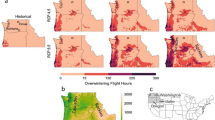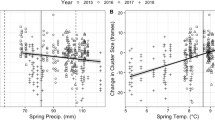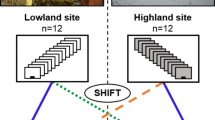Summary
This study investigated the effects of colony growth and development, food storage, foraging activity and weather on the migration behavior of African honey bees in the Okavango River Delta, Botswana. Four observation colonies were studied during the honey bee migration season (November–May), at which time the availability of blooming species was reduced. Two of the colonies (colonies 1 & 2) migrated during the study period, while the remaining two (colonies 3 & 4) did not. During the 4–6 weeks preceding the onset of migration preparations, colonies 1 & 2 exhibited increasing population sizes, high levels of brood production with low brood mortality, relatively large stores of food, and increasing mass. In contrast, the populations of colonies 3 & 4 did not increase, brood-rearing activity was erratic and lower, brood mortality was higher, food stores became depleted and colony mass declined. Both colonies 3 & 4 ceased rearing brood, and colony 3 died of starvation. Colony foraging activity was examined by monitoring waggle-dance activity 2–3 days each week. For 4–6 weeks before the onset of migration in colonies 1 & 2, daily foraging areas and mean daily foraging distances became increasingly large and variable. Colonies 3 & 4 exhibited foraging patterns similar to those observed for colonies 1 & 2 preceding migration. There was no clear association between 7 weather parameters examined and migration behavior. These data suggest that migration is influenced by an interaction of intra-colony demographics, food reserves and foraging patterns. Migration may be feasible only for those colonies that possess (1) a population of appropriate size and age structure to compensate for the natural attrition of older workers during the emigration process, and (2) sufficient food reserves for long-distance travel and the establishment of a new nest. Changing foraging patterns may reflect a deteriorating foraging environment, which may trigger the onset of migration preparations, provided that colony demographics and food reserves are conducive. Colonies that show decreased brood production, higher brood mortality and reduced food stores may be incapable of migrating, even when experiencing deteriorating foraging conditions. Rather, such colonies may have a greater chance of survival if they attempt to persist in a given area.
Similar content being viewed by others
References
Camazine, S., and R. A. Morse, 1988. The Africanized honeybee.Amer. Sci. 76:464–472.
Fletcher, D. J. C., 1978. The African bee,Apis mellifera adansonii, in Africa.Ann. Review Entomol. 23:151–171.
Fletcher, D. J. C., 1991. Interdependence of genetics and ecology in a solution to the African bee problem. In:The “African” Honey Bee (M. Spivak, D. J. C. Fletcher, and M. D. Breed, Eds.), Westview Press, Boulder, Colorado, pp. 77–94.
Fukuda, H., and S. F. Sakagami, 1968. Worker brood survival in honeybees.Res. in Pop. Ecol. 10:31–39.
Griffiths, J. F., 1976.Climate and the Environment. Westview Press, Boulder, Colorado.
Kachigan, S., 1982.Multivariate Statistical Analysis: A Conceptual Introduction. Radius Press. New York, New York, USA.
Koeniger, N., and G. Koeniger, 1980, Observations and experiments on migration and dance communication ofApis dorsata in Sri Lanka.J. Apic. Res. 19:21–34.
McNally, L. C., and S. S. Schneider, 1992. Seasonal patterns of growth, development and movement in colonies of the African honey bee,Apis mellifera scutellata, in Africa.Ins. Soc. 39:167–179.
Nightingale, J., 1976. Traditional beekeeping among Kenya tribes, and methods proposed for improvement and modernization. In:Apiculture in Tropical Climates (E. Crane, Ed.), International Bee Research Association, London, pp. 15–22.
Otis, G. W., 1991. Population biology of the Africanized honey bee. In:The “African” Honey Bee (M. Spivak, D. J. C. Fletcher and M. D. Breed, Eds.), Westview Press, Boulder, Colorado, pp. 213–234.
Otis, G. W., M. L. Winston and O. R. Taylor, 1981. Engorgement and dispersal of Africanized honey-bee swarms.J. Apic. Res. 20:3–12.
Rinderer, T. E., 1988. Evolutionary aspects of the Africanization of honey-bee populations in the Americas. In:Proceedings of the International Conference on Africanized Honey Bees and Bee Mites (G. R. Needham, R. E. Page, Jr., M. Delfinado-Baker and C. Bowman, Eds.) Westview Press, Boulder, Colorado, pp. 13–28.
Ruttner, F., 1988.Biogeography and taxonomy of honeybees. Springer-Verlag, New York, New York, USA.
Schneider, S. S., 1989. Spatial foraging patterns of the African honey bee,Apis mellifera scutellata.J. Insect. Behav. 2:505–521.
Schneider, S. S., 1990a. Nest characteristics and recruitment behavior of absconding colonies of the African honey bee,Apis mellifera scutellata, in Africa.J. Insect. Behav. 3:225–240.
Schneider, S. S., 1990b. Queen behavior and worker-queen interactions in absconding and swarming colonies of the African honey bee,Apis mellifera scutellata (Hymenoptera: Apidae).J. Kansas Entomol. Soc. 63:179–186.
Schneider, S., and R. Blyther, 1988. The habitat and nesting biology of the African honey beeApis mellifera scutellata in the Okavango River Delta, Botswana, Africa.Ins. Soc. 35:167–181.
Schneider, S. S., and L. C. McNally, 1992. Seasonal patterns of foraging activity in colonies of the African honey bee,Apis mellifera scutellata, in Africa.Ins. Soc. 39:181–193.
Seeley, T. D., 1983. Division of labor between scouts and recruits in honeybee foraging.Behav. Ecol.ociobiol. 12:253–259.
Seeley, T. D., 1985.Honeybee Ecology. Princeton University Press, Princeton, New Jersey, USA.
Shettleworth, S. J., J. R. Krebs, D. W. Stephens and J. Gibbons, 1988. Tracking a fluctuatng environment: A study of sampling.Anim. Behav. 36:87–105.
Silberrad, R., 1976.Bee-keeping in Zambia. Apimondia, Bucharest.
Sinclair, A. R. E., 1983. The function of distance movements in vertebrates. In:The ecology of animal movements (I. R. Swingland, and P. J. Greenwood, eds.), Clarendon Press, New York, New York, USA, pp. 240–258.
Sokal, R., and F. Rohlf, 1981.Biometry. W. H. Freeman, San Francisco, California, USA.
Tamm, S., 1987. Tracking varying environments: sampling by hummingbirds.Anim. Behav. 35:1725–1734.
Visscher, P. K., and T. D. Seeley, 1982. Foraging strategy of honeybee colonies in a temperature deciduous forest.Ecology 63:1790–1801.
Von Frisch, K., 1967.The Dance Language and Orientation of Bees. Harvard University Press, Cambridge, Massachusetts, USA.
Winston, M. L., 1979. Intra-colony demography and reproductive rate of the Africanized honeybee in South America.Behav. Ecol. Sociobiol. 4:279–292.
Winston, M. L., 1987.The Biology of the Honey Bee. Harvard University Press, Cambridge, Massachusetts, USA.
Winston, M. L., G. W. Otis and O. R. Taylor, 1979. Absconding behaviour of the Africanized honey bee in South America.J. Apic. Res. 18:85–94.
Winston, M. L., J. A. Dropkin and O. R. Taylor, 1981. Demography and life history characteristics of two honey bee races (Apis mellifera).Oecologia 48:407–413.
Winston, M. L., O. R. Taylor and G. W. Otis, 1983. Some differences between temperate European and tropical South American honeybees.Bee World 64:12–21.
Woyke, J., 1976. Brood rearing and absconding of tropical honey bees. In:African Bees: Taxonomy, Biology, and Economic Use (D. J. C. Fletcher, Ed.), Apimondia, Pretoria, South Africa, pp. 96–102.
Author information
Authors and Affiliations
Rights and permissions
About this article
Cite this article
Schneider, S.S., McNally, L.C. Factors influencing seasonal absconding in colonies of the African honey bee,Apis mellifera scutellata . Ins. Soc 39, 403–423 (1992). https://doi.org/10.1007/BF01240624
Received:
Revised:
Accepted:
Issue Date:
DOI: https://doi.org/10.1007/BF01240624




